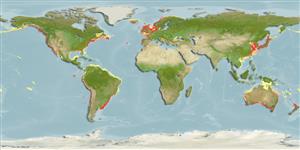Common names from other countries
Environment: milieu / climate zone / depth range / distribution range
Ecologia
; estuarina; intervalo de profundidade 0 - 90 m (Ref. 1603). Temperate; 90°N - 41°S, 180°W - 180°E
Indo-Pacific, Atlantic Ocean, Mediterranean, and the Arctic: Europe. tropical to temperate.
Length at first maturity / Tamanho / Peso / Idade
Maturity: Lm ? range ? - ? cm Max length : 4.0 cm WD macho/indeterminado; (Ref. 1749)
Attached to hard substrata or loosely attached on sandy bottoms; from lower shore to depths of about 90 (Ref. 1603). Wharf piles, ships, etc. sea grass, sand or muddy substrates in large aggregates, to 30 m, in salinity 11 to over 20 parts/thousand (Ref. 1134).
Life cycle and mating behavior
Maturidade | Reprodução | Desova | Ovos | Fecundidade | Larvas
Members of the class Ascidiacea are hermaphroditic; both cross- and self-fertilization is typical. Life cycle: Eggs develop into lecithotrophic larva before metamorphosing into benthic adults.
de Kluijver, M.J. and S.S. Ingalsuo. 2006. (Ref. 1603)
Status na Lista Vermelha da IUCN (Ref. 130435)
Status no CITES (Ref. 108899)
Not Evaluated
Not Evaluated
Uso pelos humanos
| FishSource |
Ferramentas
Mais informação
Idade/TamanhoCrescimentoComprimento-pesoComprimento-comprimentoMorfologiaLarvasAbundância
Fontes da internet
Estimates based on models
Preferred temperature
(Ref.
115969): 8.4 - 24.3, mean 13.5 (based on 1814 cells).
Vulnerabilidade
Low vulnerability (10 of 100).
Categoria de preço
Unknown.
